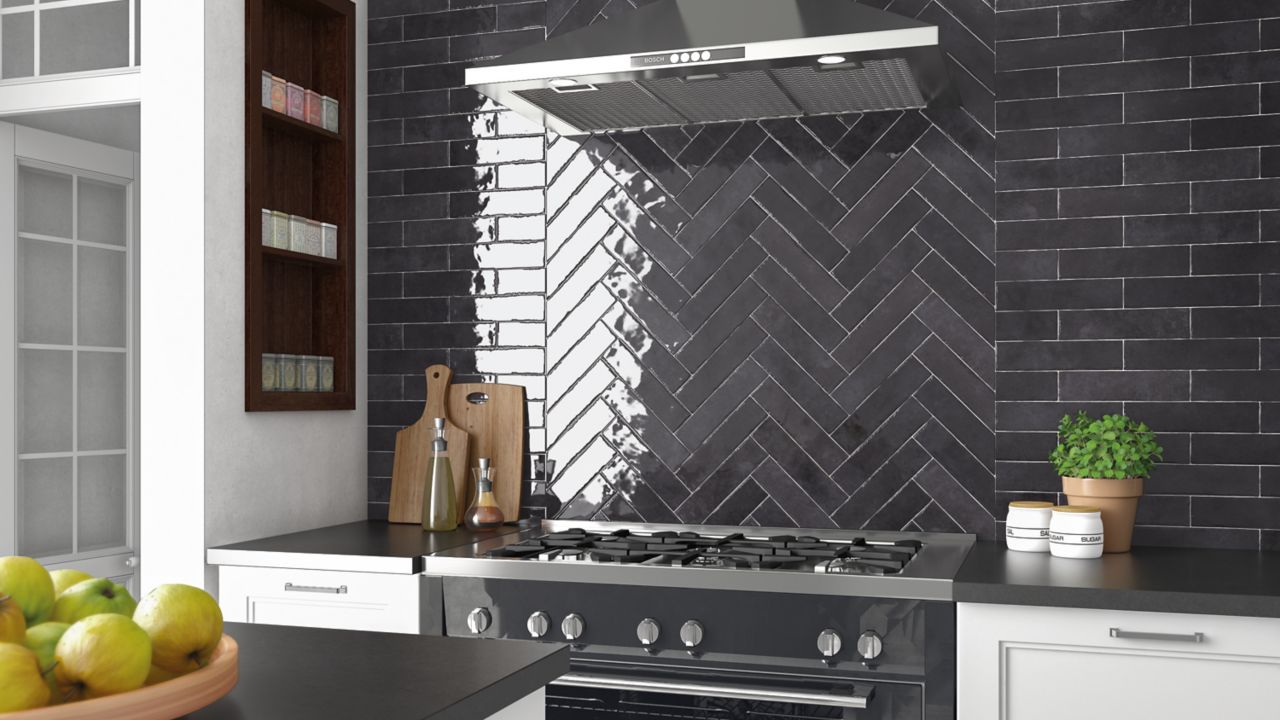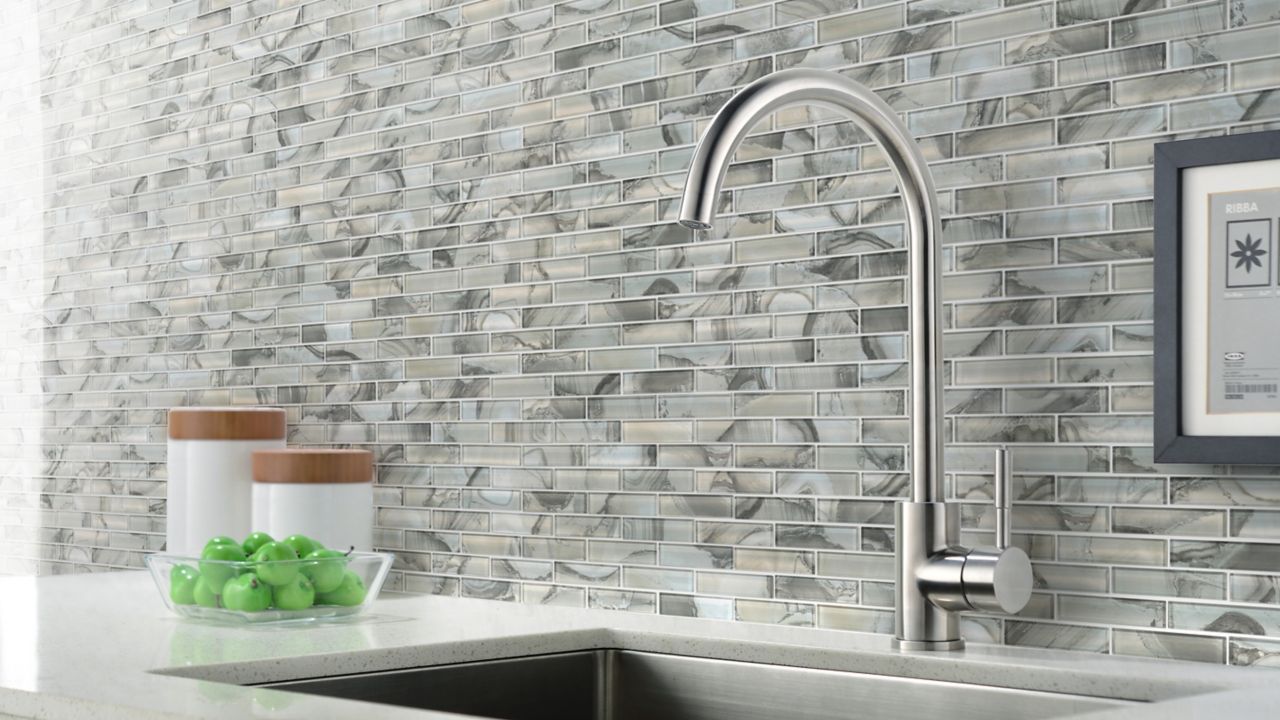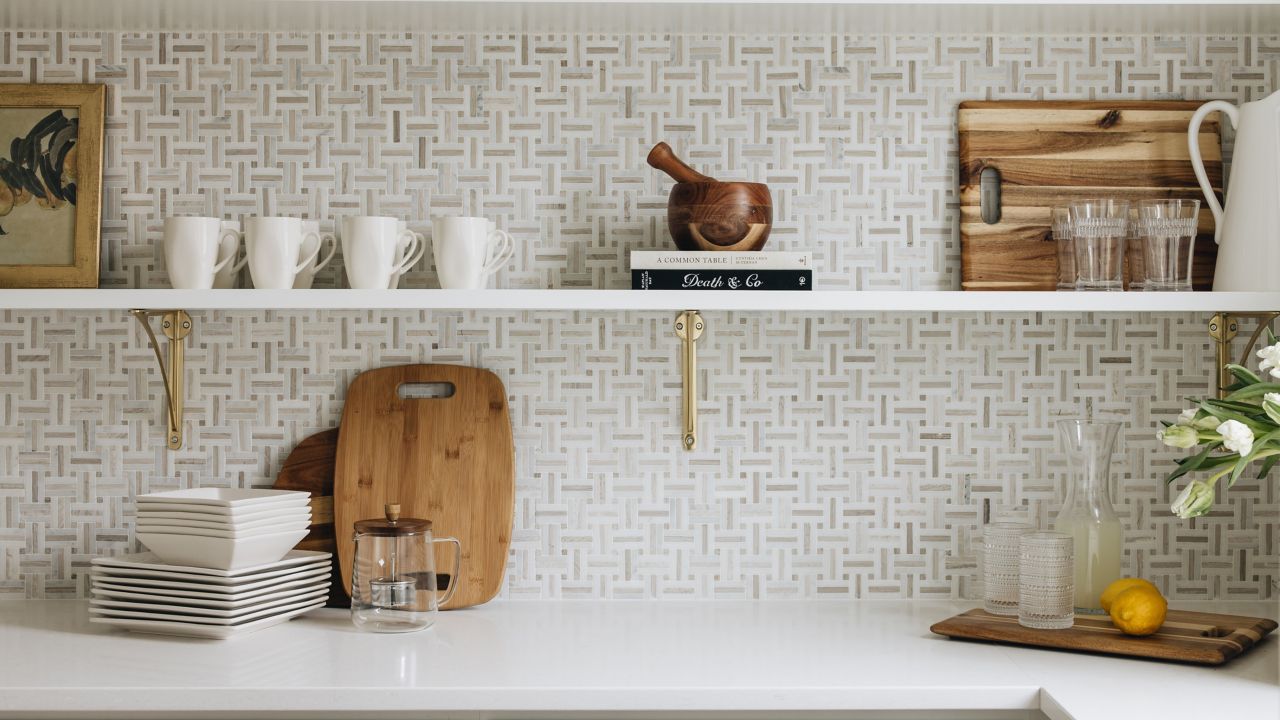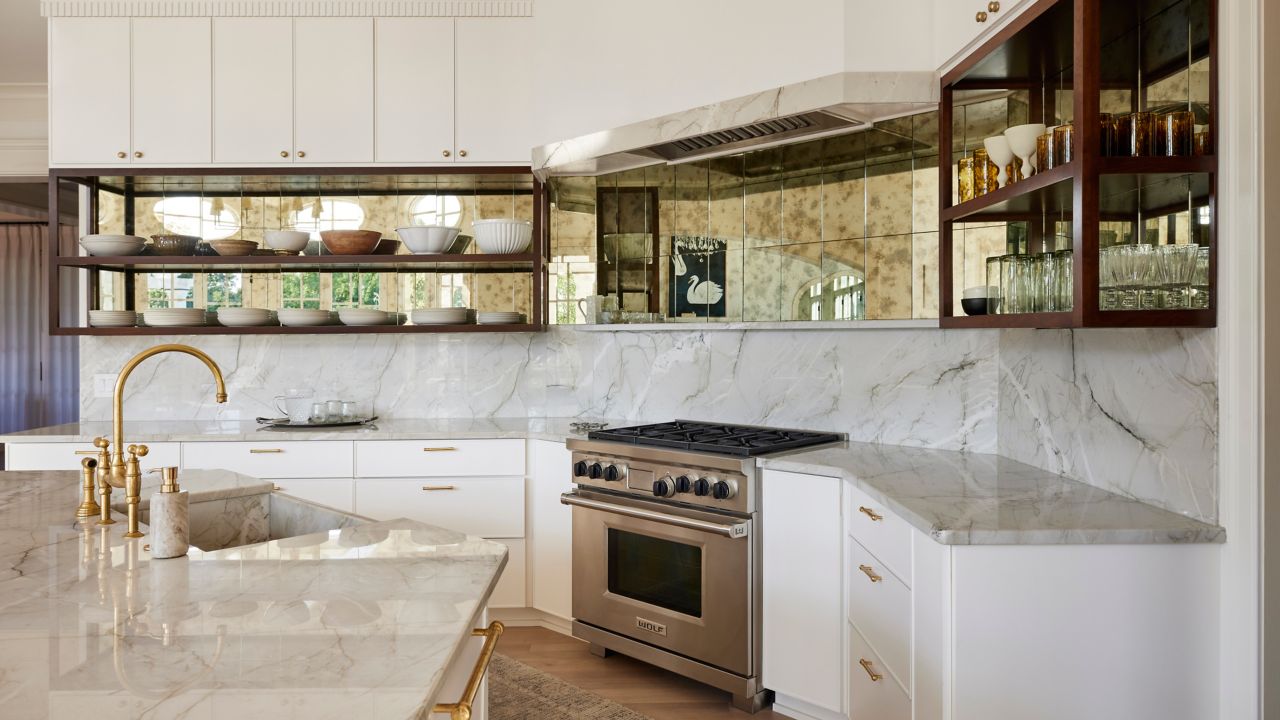Best Materials for Your Kitchen Backsplash

Your backsplash has an outsized impact on the look and feel of your kitchen. Whether you are planning a busy pattern that draws attention to itself or a classic, neutral subway tile that blends into the background, choosing the right material is important. Getting the wrong kind of tile can lead to chipping, sagging, staining and all sorts of other hassles.
Factors to Consider When Choosing Your Backsplash Material

The elements that make up the best kitchen backsplash tile can be varied and will often depend on your personal preferences and priorities. Still, there are three major factors to consider before making a final decision:
Ease of Installation
If you are planning to install your own kitchen backsplash, it's important to consider how easy it will be to install the tile. Factors that may otherwise be desirable, such as hardness and larger size, could become drawbacks as these can make tiles harder to cut. You may also want to consider a tile that comes affixed to a mesh backing to avoid installing one tile at a time.
Hiring a professional to install your tile will expand your tile options to include any specialty materials or intricate layouts. However, you will need to include those labor costs within your overall project budget.
Maintenance
One of the best things about a beautiful tile backsplash is that it's always visible. The flip side to that is, when it gets dirty, that grime may be all you see. This is why it's a good idea to choose a backsplash tile that is easy to clean and maintain.
The key to easy backsplash maintenance is to opt for a low-porosity or totally nonporous tile material—this includes porcelain, glass, glazed ceramic, and sealed natural stone. Some finishes, like glossy or polished surfaces, can be easier to maintain than matte or textured surfaces. And the larger your tiles, the fewer grout lines you’ll need per square foot of wall—which can make tiles easier to wipe down, and reduce the time you’ll spend cleaning grout lines over the life of your backsplash.
Make sure you understand the maintenance requirements of the tile you choose, so that you can protect your investment—and keep it looking like new—for years to come. For more tricks for keeping your tile backsplash as low maintenance as possible, see the section below, Design Tips for Reducing Backsplash Maintenance.
Aesthetics
Your backsplash is a highly visible element that can either blend in or stand out—so consider how it fits into the overall design of your kitchen. Look at your countertop material, cabinet color, and finish of your fixtures to decide if you want contrast or cohesion. For a clean, minimalist look, try tiles in neutral shades with matte or satin finishes. For more personality, choose patterned tiles, glossy finishes, or bold colors. Textured or handmade-look tiles can add warmth and depth, while stone-look or metallic finishes work well in industrial or rustic spaces. Think about whether you want your backsplash to be a subtle backdrop or a focal point that draws attention.
Top Kitchen Backsplash Materials

Ceramic & Porcelain
Key Features: Ceramic and porcelain tiles are both popular choices for kitchen backsplashes. These tiles are often grouped together, but they do have some important differences. Still, these two offer a similar amount of versatility in size, shape, color and design, from classic white subway tiles to mosaics and unique shapes, or designs that mimic natural materials like stone or wood.
Pros: Porcelain and most ceramic tiles are nonporous, which makes them easy to clean when the inevitable splashes and spills happen. Both tile materials are also very durable, with porcelain edging out ceramic as one of the toughest tile materials. On the other hand, this also makes ceramic tiles easier to cut, which can make DIY installation more approachable.
Cons: Most ceramic tiles are glazed and treated during manufacturing to seal out moisture and stains, but untreated ceramic—while not common—is highly porous, and therefore not well suited to use on a kitchen backsplash.
Porcelain is a little more challenging to install because it's harder to cut than ceramic and requires a special high latex adhesive. Check out our article on how to cut tile to learn more.
Glass
Key features: Glass tiles tend to be translucent, slightly reflective and offer a variety of vivid colors. Rectangles, squares and hexagons are the most common shapes of glass tiles, but you’ll also find shapes like round, arabesque, and chevron. Some glass tiles don’t look “glassy” at all; rather, they mimic stone, marble and other natural materials, which further expands your design options in applications where glass is your best option. Glass tiles are available in varying sizes and are typically affixed to mesh backing.
Pros: The reflective nature of glass tile—which includes mirrored tile—can amplify the natural light in your kitchen and make it seem bigger and brighter. Glass is also nonporous, which means there is no worry about the tiles staining, even if they are splashed with tomato sauce. This nonporosity also makes them remarkably easy to clean, requiring only some glass cleaner and a rag or paper towel.
Cons: Glass tiles are considered more difficult to install than some other tile types. They require specialized tools to cut, which can be challenging and time consuming for a DIY enthusiast to get the hang of. This usually means that installing a glass tile backsplash is best left to professionals, which can mean higher installation costs compared to a DIY installation.
Natural Stone
Key features: Natural stone tiles are cut from quarried stone such as marble, travertine, limestone and slate. These materials offer a wide variety of styles and color options, from white and beige to black and grey and a whole rainbow of earth tones in between.
Pros: The natural quality of stone tiles also means each piece is unique, with its own veining and texture. This makes your backsplash a work of art that can't be found anywhere else.
Natural stone tiles can also withstand extreme temperature changes. This makes them well suited to be installed behind ovens, because they won't expand or contract before or after being exposed to heat.
Cons: Natural stone tiles are usually porous, so you will need to regularly seal them to prevent staining. This can be done relatively easily by following the manufacturer's instructions, but it is vital that you keep up with it or you risk stains from splashed food.
Porcelain Panels and Slabs
Key features: These man-made, slab-style panels offer the oversize, luxe look of natural stone slabs, combined with the durability, ease and affordability of porcelain. Porcelain panels are sold in kits for tub and shower surround applications; if you're installing a kitchen backsplash, you can purchase individual porcelain slabs to customize your design.
Pros: Porcelain slabs offer the look of natural stone at a fraction of the price of a true stone slab. Porcelain panels and slabs are even larger than large format tiles—for instance, depending on the dimensions of your kitchen, it could be possible to cover entire walls with single panels, with the only lines at corners of walls and where the backsplash meets the counter. Porcelain panels and slabs also weigh less than stone pieces of the same size, and they require less maintenance than stone, because porcelain does not require sealing.
Cons: Porcelain panels are not DIY-friendly, as they require specific experience and tools to install correctly. If not installed by qualified professionals using the proper tools, these slabs are at risk of breaking or cracking due to their large size. The substrate must be prepared carefully, and the installation phase requires at least two qualified professionals working simultaneously. This level of experience and extra manpower should be factored into your project budget.
Metal Tile or Panels
Key features: Metal tile and panels are most frequently made from copper, stainless steel, aluminum or tin. Common tile shapes include penny rounds and other mosaics (both single- and mixed-material designs, which pair metal tiles with pieces of glass, stone or another material). Mosaics are affixed to a mesh backing for easier installation. Metal panels, which are not actually tiles at all, are another popular look, and are used to cover large areas, particularly in commercial or mixed-use spaces like restaurants and workshops.
Pros: Metal tiles aren’t nearly as common a choice for kitchen backsplashes as other materials, so installing them will offer a unique look that’s sure to make a bold statement. They are also highly durable and resistant to heat, so there is no concern about warping, cracking or chipping. Metal is also stain resistant, so cleaning up and splashes or spills is always easy.
Cons: Metal tiles require significantly more processing to manufacture, so their cost per square foot is higher than most other tile materials. There is also the possibility that a softer metal tile, such as copper, could dent if struck hard enough—not a likely occurrence as a kitchen backsplash, but still a factor worth paying attention to.
Design Tips for Reducing Backsplash Maintenance

Use larger tiles or panels
The most high-maintenance area of any backsplash is grout lines. To reduce maintenance, reduce grout lines by opting for larger tiles.
Once installed, your backsplash tiles will be nearly maintenance free (unless they are a material that requires periodic sealing, such as ceramic or natural stone).
Use high-quality grout and sealant
You can protect your grout lines by sealing them. A high-quality sealant will create an impermeable barrier that will block moisture, grease and grime from penetrating the grout. And for any changes of plane—such as where interior walls meet, or where your backsplash meets your counter—use grout-matching silicone to allow for expansion and enhance water resistance.
Finishes and patterns make a difference
Nearly maintenance free doesn't mean entirely maintenance free. You will still need to wipe down your backsplash tiles from time to time to remove buildup of small water splatter or light dust. One way to reduce the frequency of wipedowns is to pay close attention to patterns and finishes. Any messes will be most visible on backsplashes in a single solid color or with a high gloss finish, while patterned tiles and matte finishes will will help camouflage dirt and grime.
Kitchen Backsplash FAQ
What type of backsplash is easiest to clean?
The easiest type of backsplash to clean is one made up of large, nonporous tiles. The trick to easy cleaning is to reduce grout lines and have a smooth, wipeable surface. In fact, having fewer grout lines will make more of an impact on ease of cleaning than which type of tile material you pick, because the grout lines are the most susceptible to grime build up and staining.
Are natural stone backsplashes hard to maintain?
A natural stone backsplash is the epitome of luxurious style. That style does require additional upkeep in the form of periodic sealing of the tiles. The sealing process is relatively simple and can be done in an afternoon. If you allow the sealant to degrade, you risk exposing the underlying porosity to the elements of your kitchen, which could lead to staining.
How can I keep my backsplash grout from getting dirty?
No matter how much you try to protect it, your backsplash grout is bound to get dirty. The ambient oils and steam from cooking will settle into the porous grout and, if left unchecked, will start to make it look dingy and may even cause it to start cracking.
The best way to keep your backsplash grout lines looking clean is to clean the grout regularly. Cleaning grout is a simple process that is easier the more often you do it. A quick wipedown once a week with a dish soap and water mixture should keep it looking fresh. As always, follow the manufacturer's instructions for the best results.